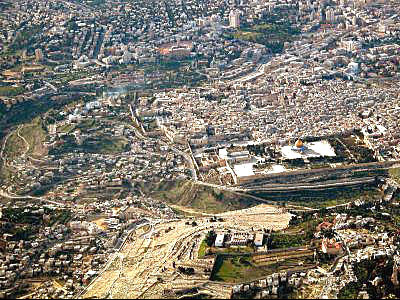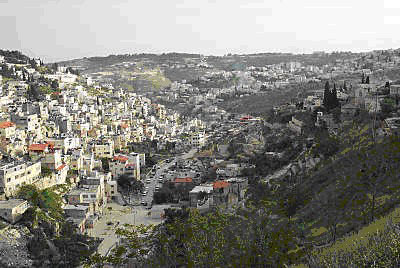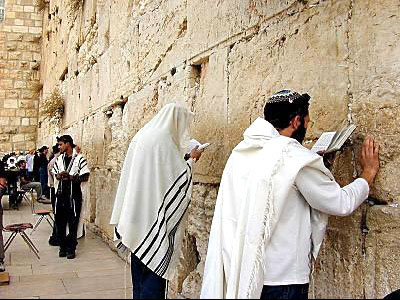Jerusalem
 |
City of David and Dome of the Rock ,Center Right. Kidron Valley, center foreground, left to right. Mount of Olives bottom of photo. The original city of Jerusalem was built around the Gihon Spring on the hill to the left of the City of David over 1500 years before the Exodus from Egypt. The City of David, roughly outlined by the walls surrounding the Dome of the Rock and the Temple Mount shown in the photo, used the Gihon spring as its main water source. After Hezekiah became king in 715 BC he had a 600 yard tunnel built from the Gihon Spring into Jerusalem. The tunnel was started at both the spring and inside the City the city walls. The two crews of workmen came toward each other and joined the two segments of tunnel by each crew tunneling toward the noise made by the other. This is presumably the reason for the S-shape of the tunnel. In 1880 a Hebrew inscription was found on the tunnel wall describing how the workmen joined the two sections. After the tunnel was completed, Hezekiah sealed off the cave entrance to the spring, thereby securing the water supply to Jerusalem. |
 |
Kidron Valley looking south. City of David off the photo to the right (northwest). The City of David was under 100 yards wide and covered an area that could be occupied by a small village in today's world. It was protected by steep slopes on 3 sides. |
 |
The Western Wall, built by Herod The Great Three times a day the Jewish people pray here in this place, which is holy to them, wearing their traditional prayer garments. The prayer shawl is frequently used, even by soldiers in the field, during prayer times. Photos Courtesy of BiblePlaces.com ______________________________________ The following is from Easton's Bible Dictionary Called also Salem, Ariel, Jebus, the “city of God,” the “holy city;” by the modern Arabs el-Khuds, meaning “the holy;” once “the city of Judah” (2 Chr. 25:28). This name is in the original in the dual form, and means “possession of peace,” or “foundation of peace.” The dual form probably refers to the two mountains on which it was built, viz., Zion and Moriah; or, as some suppose, to the two parts of the city, the “upper” and the “lower city.” Jerusalem is a “mountain city enthroned on a mountain fastness” (compare Ps. 68:15, 16; 87:1; 125:2; 76:1, 2; 122:3). It stands on the edge of one of the highest table-lands in Palestine, and is surrounded on the south-eastern, the southern, and the western sides by deep and precipitous ravines. |